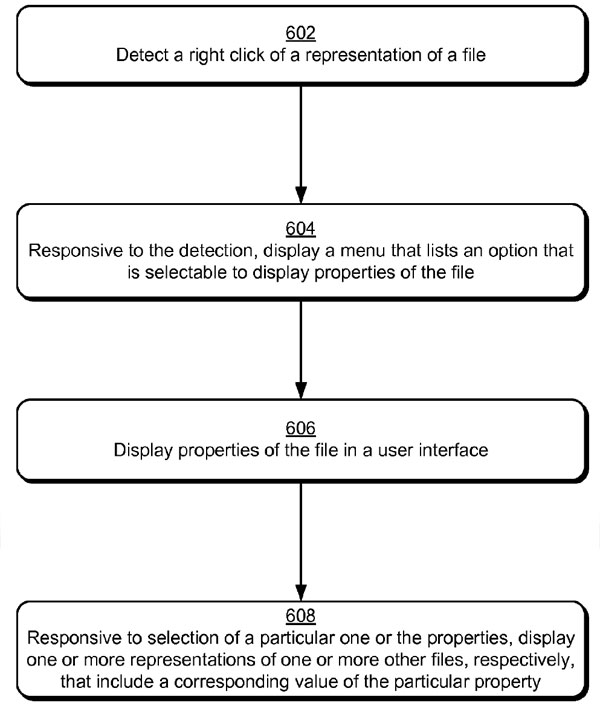Microsoft Patent Application Hints at Kinect Context Menu
Microsoft submitted a patent application that suggests the company will be holding on to the right-click context menu Windows users are used to.
Both the description of the patent as well as the illustration do not immediately imply any major changes to the context menu as it is implemented today. The most significant change may be a semantic feature to present related files to a selected file.
However, the filing date of November 2010, as well as one particularly interesting paragraph describing an "example implementation," hint at an evolutionary stage for the old Windows feature:
"FIG. 6 depicts a procedure 600 in an example implementation in which properties are used as pivots to navigate through files in a user interface. A right click of a representation of a file is detected (block 602). A user, for instance, may perform a two-finger tap-and-hold gesture over a display the representation, make a gesture "in the air" that is captured by a camera as part of a natural user interface, through use of a mouse, stylus, and so forth. Additionally, the representation may be configured in a variety of ways, such as an icon, thumbnail, textual description, and so forth. As illustrated, the user may select a representation of a patent application document using the right click."
While the touch UI has some appeal, the interesting part obviously is the mention of an "in the air gesture" that corresponds with a Kinect interface for Windows as well as Microsoft's early intentions to not limit Kinect to the Xbox 360, but move it to a traditional computing interface. Kinect was launched on November 4, 2010.
There has been suspicion that Microsoft has been betting big on Kinect for Windows, or at least an evolved version of the device that features a much higher resolution as well as a capability to detect more granular body parts, such as fingers. Such a feature would enable Microsoft to offer gesture-based context menus and evolve the touch UI to a gesture UI.
Get Tom's Hardware's best news and in-depth reviews, straight to your inbox.

Douglas Perry was a freelance writer for Tom's Hardware covering semiconductors, storage technology, quantum computing, and processor power delivery. He has authored several books and is currently an editor for The Oregonian/OregonLive.
-
jkflipflop98 Whargarble!!!! I CAN'T USE AN INPUT THAT ISN'T COMPRISED OF 2D POINTS ON A FLAT PLANE!!!! HOW DARE YOU TRY SOMETHING NEW AND INNOVATIVE!! I WANT MY WIN98 BACK BEST OS EVER WAGGLE MY ARMS WHARGARBLLELELELEReply
/neckbeard off. -
JOSHSKORN Hold onto the right-click context menu? Hows about holding onto that Start Button too while you're at it, and ditching that ridiculous Metro UI for Desktop users, as well. How many Desktop users actually have a touch screen, anyway? That's like asking how many people had Macs in the 90s.Reply -
jkflipflop98 JOSHSKORNHold onto the right-click context menu? Hows about holding onto that Start Button too while you're at it, and ditching that ridiculous Metro UI for Desktop users, as well. How many Desktop users actually have a touch screen, anyway? That's like asking how many people had Macs in the 90s.Reply
Hell, while we're at it why don't we just ditch the stupid GUI altogether and go back to the glory days of DOS 5? I mean, if we're all about stopping innovation because you can't be bothered to learn where a new function is, we may as well go full-tilt retro back to command lines.
Or you can reinstall Win98 and live in your little bubble of kainolophobia while the rest of us continue to evolve. -
alidan jkflipflop98Hell, while we're at it why don't we just ditch the stupid GUI altogether and go back to the glory days of DOS 5? I mean, if we're all about stopping innovation because you can't be bothered to learn where a new function is, we may as well go full-tilt retro back to command lines. Or you can reinstall Win98 and live in your little bubble of kainolophobia while the rest of us continue to evolve.jkflipflop98Whargarble!!!! I CAN'T USE AN INPUT THAT ISN'T COMPRISED OF 2D POINTS ON A FLAT PLANE!!!! HOW DARE YOU TRY SOMETHING NEW AND INNOVATIVE!! I WANT MY WIN98 BACK BEST OS EVER WAGGLE MY ARMS WHARGARBLLELELELE/neckbeard off.Reply
i honestly had to check to see if that was just a troll account or not.
metro is a huge step in the wrong direction, microsoft is chasing after people who dont want a computer with this os, and failed to make it better for people who do use a computer. sure you could force us to learn all the keyboard shortcuts, or just make the os do what we are use to, and if people want to screw around with something new, than let them.
either that or just dont put this os out on the computer, because im fairly sure everyone who knows of win 8 right now came to the same conclusion, its for cellphones and tablets only, and the only reason we are getting it is because some tablets are x86.
it will be a great tablet os, but horrific for pc users.
stop taking windows in bad directions, its all we really want.
and kinect is a failure for controlling anything, it has applications, but not in user interface. -
Zetto Reply9372258 said:i honestly had to check to see if that was just a troll account or not.
metro is a huge step in the wrong direction, microsoft is chasing after people who dont want a computer with this os, and failed to make it better for people who do use a computer. sure you could force us to learn all the keyboard shortcuts, or just make the os do what we are use to, and if people want to screw around with something new, than let them.
either that or just dont put this os out on the computer, because im fairly sure everyone who knows of win 8 right now came to the same conclusion, its for cellphones and tablets only, and the only reason we are getting it is because some tablets are x86.
it will be a great tablet os, but horrific for pc users.
stop taking windows in bad directions, its all we really want.
and kinect is a failure for controlling anything, it has applications, but not in user interface.
You kids need to get with the program tbh.
My 90 year old dad has an all in one touch with Win 7.
He loves it and can't wait for the Win 8 upgrade.
Embrace positive change or get left behind, gesture based ui is the future, AND it will be superior to the old mouse/start menu days.
-
jkflipflop98 ZettoYou kids need to get with the program tbh. My 90 year old dad has an all in one touch with Win 7. He loves it and can't wait for the Win 8 upgrade.Embrace positive change or get left behind, gesture based ui is the future, AND it will be superior to the old mouse/start menu days.Reply
The world is full of "experts" that can't see past the end of their nose. -
the_brute How did most of these "experts" learn how to use touch screens? And these same people love UIs that already dont have a start menu, but if Microsoft changes its the end of the world I guess.Reply
Time to reboot my win 3.11 because why would people even try to get away from the CMD interface that is so refined. -
bigdog44 You have the right to change how you use the Start button.Reply
You have the right to not buy if you dont like it.
You have the right to remain silent and not whine. -
I'll continue to use Vista on my 5 year old gaming machine, never had any problems with it (got it when SP2 was out).Reply
As a matter of fact, Vista SP2 "IS" windows 7.
If people bashed windows vista so bad because of idiot manufacturers using faulty drivers that made the PC crash, Then in return blacked Vista when it was the lazy developers AKA nvidia, and millions of others. then Windows 8 should be bashed for being utterly retarded on all levels. Windows 8 will crash worse than a drunk driver. -
someoneelse jkflipflop98Hell, while we're at it why don't we just ditch the stupid GUI altogether and go back to the glory days of DOS 5? I mean, if we're all about stopping innovation because you can't be bothered to learn where a new function is, we may as well go full-tilt retro back to command lines. Or you can reinstall Win98 and live in your little bubble of kainolophobia while the rest of us continue to evolve.Reply
Sorry but this arguement for metro interface is moronic.
There is a difference between good innovation and bad innovation. No one complained about XP or W7 because they were good innovation. Good innovation drives sales. Bad innovation drives customers away.
Metro is clearly better suited to the less than 1% of windows touch devices that do exist in a currently limited "touch OS" market. In the mean time most mainstream buyers ( laptops and desktops ) will take one look at W8 on their next potential laptop and either not bother upgrading or go to the apple store ( yes they'll be downgrade to w7 options but most people want something that works out of the box with zero hassle).
The biggest loosers of all this could be intel as fewer people upgrade to ivy bridge mobile because they don't like the metro interface. Nevermind. Microsoft will learn about customer choice once they loose enough sales. The tech press has been somewhat forgiving of metro. I doubt the public will be so open minded. The writings on almost every forum wall - if MS can't see it that's their problem.
